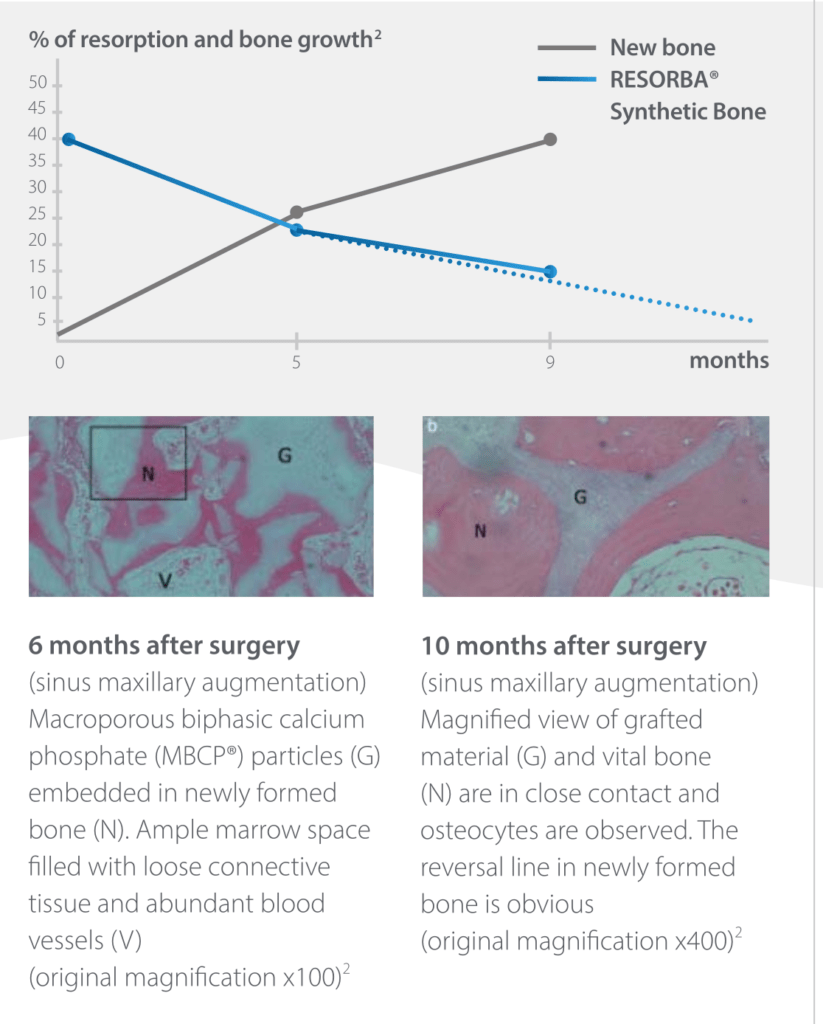VON SMARTEN SYNTHETISCHEN MATERIALIEN ZU NATÜRLICHEN KNOCHEN

Mikro-makroporöses biphasisches Kalziumphosphat (MBCP®)
Vor mehr als 30 Jahren hat Biomatlante*, ein etablierter Entwickler und Hersteller von innovativen chirurgischen synthetischen Biomaterialien, eine Technik zur Herstellung von biphasischem Calciumphosphat (HA/ß-TCP) mit Mikro- und Makroporosität und erfand das mikro-makroporöse Biphasisches Kalziumphosphat (MBCP®).
Calciumhydroxylapatit (HA) ist ein Hauptbestandteil der Mineralphase der menschlichen Knochen und Zähne. Dank
seiner chemischen Zusammensetzung, die der chemischen Phase des Knochengewebes ähnelt, ist es ein biokompatibles Material bekannt für die Stimulierung des Knochenwachstums. Durch seine Langzeitstabilität bietet HA ein stabiles Gerüst für die Zelladhäsion Gerüst für die Zelladhäsion, während ß-TCP, das löslicher ist und eine schnelle Bioreaktivität aufweist, das schnelle Einwachsen von pluripotenten regenerativen Zellen fördert.
Die freigesetzten Kalzium- und Phosphat-Ionen stimulieren die Bildung von Osteoid durch die wandernden Osteoblasten. Diese spezifische biphasische Zusammensetzung bietet optimale Leistungen für einen allmählichen Ersatz des Ersatzmaterials durch das natürliche Knochengewebe ohne Volumenverlust.
Das zusammenhängende Netzwerk von Makroporen und Mikroporen bietet eine globale Porosität von von mindestens 70 %, ähnlich wie bei spongiösem Knochen. Die gesamte Oberfläche wird von körpereigenen Zellen besiedelt. Die Gesamtresorptionszeit des Produkts hängt von zahlreichen Faktoren ab, wie der Größe des Knochendefekts, seiner Lage, dem chirurgischen Protokoll und dem Gesundheitszustand des Patienten ab.

RESORBA® Synthetic Bone – eine sichere Wahl

Wichtigste Indikationen
- Füllung parodontaler/knöcherner Defekte
- Kamm-Augmentation
- Implantataufbereitung, Einsetzen in Extraktionsstellen
- Sinus-Lifting
- Füllung zystischer Kavitäten
Therapeutische Vorschläge
- Verwendung als Extender für Autotransplantate
- Implantologie
- Verfahren der gesteuerten Knochenregeneration (GBR)
- Sinus-Lift-Augmentation
- Vertikale Kamm-Augmentation
- Horizontale Alveolarkamm-Augmentation
- Alveolare Regeneration – Extraktionsalveole
- Parodontologie
- Intraossäre Taschen
- Furkationen
- Intraossäre Taschen
2 Resorptionsprofile
RESORBA Synthetic Bone „Slow“60% HA / 40% B-TCP• Zweiphasiges Kalziumphosphat (MBCP® Technologie), 60% HA / 40% ß-TCP• 70 % Porosität dank miteinander verbundener Makro- und Mikroporen
- Der hohe Anteil von HA bewirkt eine langfristige Volumenstabilität durch die langsamere Resorptionsrate
RESORBA Synthetic Bone „Fast“20% HA / 80% B-TCP• Zweiphasiges Kalziumphosphat (MBCP® Technologie), 20% HA / 80% ß-TCP• 70 % Porosität dank miteinander verbundener Makro- und Mikroporen
- Der hohe Anteil von schnell löslichem B-TCP fördert die Bildung von natürlichen Knochen.
Wesentliche Merkmale
- Maximale Durchlässigkeit
- 70%ige globale Porosität – ähnlich wie bei spongiösem Knochen
- Einfach zu verwenden
- Verschiedene Formen und Verhältnisse verfügbar
- Osteokonduktiv – bietet ein Gerüst für neues Knochenwachstum
- Biphasische Zusammensetzung von HA und TCP bietet optimale Leistungen für einen allmählichen Ersatz des Ersatzmaterials durch menschlichen Knochen
Über 30 Jahre Klinische Refahrung
Mehr als 1 Million Einheiten produziert.
RESORBA® Synthetic Bone – Mischen mit körpereigenem Knochen
In Fällen, in denen eine verbesserte Neovaskularisierung und eine verstärkte frühe Knochenbildung erforderlich sind, wie bei Transplantationen außerhalb der Kammkontur, kann RESORBA® Synthetic Bone als Autotransplantat verwendet werden.
Publications
- Eight Year Clinical Follow-Up of Sinus Grafts with Micro-
Macroporous Biphasic Calcium Phosphate Granules
“After 6–8 months, sinuses that had been filled with MBCP®
granules displayed enough bone ingrowth to support dental
implants. Moreover, the bone architecture remained suitable
for mechanical stability over time. Strikingly, no significant loss
of bone height was observed after eight years.”
Seong KC, Cho KS, Daculsi C, Seris E, Guy D. Eight-Year Clinical Follow-Up
of Sinus Grafts with Micro-Macroporous Biphasic Calcium Phosphate
Granules. Key Engineering Materials. 2014;587:321-4. - Histologic and clinical evaluation for maxillary sinus
augmentation using macroporous biphasic calcium
phosphate in human “These results show that MBCP® can
be used as a grafting material for sinus floor augmentation,
whether combined with other bone graft materials or not,
and lead to a predictable prognosis for dental implants in the
posterior maxillary area where there is insufficient vertical
height for fixture installation.”
Lee JH, Jung UW, Kim CS, Choi SH, Cho KS. Histologic and clinical
evaluation for maxillary sinus augmentation using macroporous biphasic
calcium phosphate in human. Clin Oral Implants Res. 2008;19(8):767-71. - The safety and efficacy of an injectable bone substitute
in dental sockets demonstrated in a human clinical trial
“The BCP® granules appeared in direct contact with
mineralized bone tissue, thereby supporting bone growth. A
gradual substitution of the filler by bone tissue was observed
thus preserving the height of the alveolar bone crest.”
Weiss P, Layrolle P, Clergeau LP, Enckel B, Pilet P, Amouriq Y, et al. The
safety and efficacy of an injectable bone substitute in dental sockets demonstrated
in a human clinical trial. Biomaterials. 2007;28(22):3295-305. - Five Years Clinical Follow up Bone Regeneration with CaP
Bioceramics “This data confirm the resorbability
on time of
MBCP® and the scaffold effect of the HA content and high
osteoconduction property. These two properties involved a
balance resorption and bone ingrowth at the expense of the
micro macroporous bioceramics.”
Rodríguez C, Jean A, Mitja S, Daculsi G. Five Years Clinical Follow-Up
Bone Regeneration with CaP Bioceramics. Key Engineering Materials.
2008;361-363:1339-42. - Clinical Performance of Moldable Bioceramics and
Resorbable Membrane for Bone and Mucosa Regeneration
in Maxillofacial Surgery “The highly kinetic process
of resorption/absorption and bone in growth was achieved
within a few months. The bone ingrowth was architectured
and well vascularized.”
Guy D, Elodie S, Verner C, Kimakhe S. Clinical Performance of Moldable
Bioceramics and Resorbable Membrane for Bone and Mucosa Regeneration
in Maxillofacial Surgery. Biomaterials and Medical Applications. 2017;1(2).
